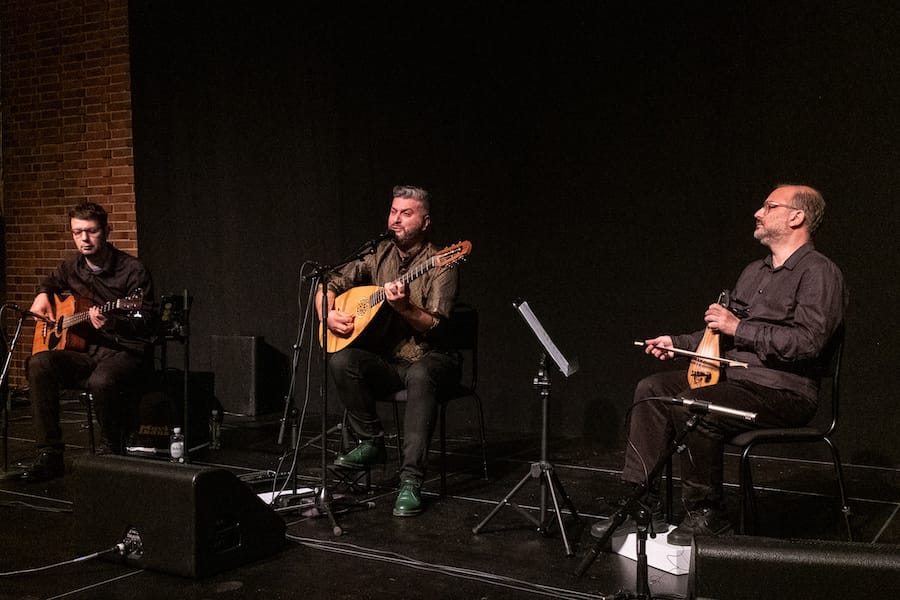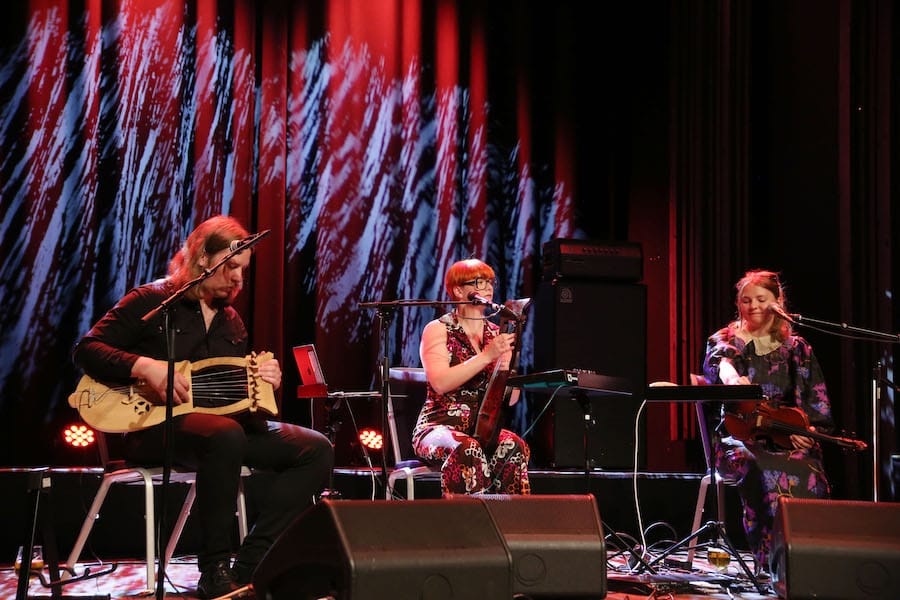Just back from the cooler climes of Norway, Robin Denselow shares some of his highlights from this year’s Førde Traditional and World Music Festival, the largest festival for trad and world music in Scandinavia.
Førde is an inspired but unlikely setting for a major music festival. It’s a little town straddling a river and surrounded by mountains up in the Norwegian fjords to the north of Bergen. It is reached either through its tiny airport or by taking a train, bus and boat trip past the waterfalls and snow-covered highlands of this empty, wild coastline. But for the past 32 years, it has been the setting for an event that sets out to showcase the best new Norwegian music alongside musicians from around the world. And for the five days of the festival, there is music all over town. Some of the concerts are in a sports complex that somehow boasts four fine music venues of different sizes. Then there are events in a hotel, an art museum, a church, a coffee shop, in the town square, and even in houses and barns.

This year there were three overlapping groups of musicians: the well-known international artists, the Norwegians, and those who took part in the opening concert, which highlighted the festival theme, Music In Times of Crisis. The latter was a decidedly varied selection, ranging from exiles who have escaped from current political horrors to those who have survived upheavals in the past. So the slick opening concert featured a taster (two songs each) from those who would be playing full-length sets later in the festival. They included the Bosnian sevdah star Damir Imamović and the veteran and legendary hero of the Congolese rumba scene, guitarist Dizzy Mandjeku, who played alongside everyone from Tabu Ley and Franco in OK Jazz, and revived the gloriously cheerful music that provided the soundtrack for the violent era of his country’s independence.
Then there were two compelling female singers, Atine from Iran and Elaha Soroor from Afghanistan, two countries where they would be risking their lives if they were performing back home. Soroor was particularly impressive during her main show at a late-night dance session where she came on in an outfit that would have given the mullahs a heart attack. She reminded her audience that “I’m lucky to be singing. If I was in Afghanistan I would be in prison or killed”, as she launched into a selection of traditional songs and songs banned by the authorities, backed by the excellent Kefaya, who switched between delicate Asian melodies and pounding rock.
Norwegian musicians reminded the audience that there had also been musical censorship far closer to home. The Romani singer and storyteller Elias Akselsen was backed by accordion and fiddle for his emotional re-working of the songs of the Norwegian Romani, who faced persecution for hundreds of years, while Ulla Pirttijärvi from the Finnish part of Lapland provided a powerful and adventurous reminder that the joiks, the passionate, often unworldly-sounding songs of the Sámi people were once banned in Norway. Her songs may have had ancient roots, but the settings were wildly modern and adventurous.
Ulla is a member of Áššu, a trio who won awards for their self-titled debut album three years ago and are now back with a remarkable new line-up. She was flanked on one side by Olav Torget, who started with a wash of effects on electric guitar before switching to bluesy riffs and then the West African n’goni (which he studied in Dakar). On the other side was the trio’s new percussionist Kenneth Ekornes, who has taken over following the death of Harald Skullerud, and who introduced sonic effects that ranged from glacial-sounding scraping noises to frame drum, bells and cajun. This was their first performance together, and they succeeded thanks to their passion and originality and the way that guitar and percussion responded to Ulla’s remarkable vocals.

If Áššu were one great Norwegian discovery of the week, then the second was Ævestaden, another new band mixing the ancient and the modern. A Norwegian-Swedish trio, they featured an unlikely line-up in which that ancient instrument, the lyre, was matched against Hardanger fiddle, vocals and electronica, with the subtle soundscapes suddenly broken up by the rousing Jew’s harp work of multi-instrumentalist Kenneth Lien. They all studied at the Norwegian Academy of Music, which is clearly having an impact on the country’s new folk scene – other impressive graduates included the young female a capella trio Aurom, who sang with no amplification in an art museum as they mixed folk influences and eerie experimentation in their updated medieval horror stories of monsters dragging villagers off into the forests or mountains.
Alongside all this was an equally wildly varied selection of international artists, ranging from the Nakibembe Xylophone Troupe from Uganda, featuring six musicians seated around a giant wooden xylophone, the embaire, on which they beat out frantic and complex rhythms, through to the gypsy band Bassant from Rajasthan, who tried to compensate for some energetic if fairly unremarkable tabla and harmonium work by bringing on a dancer with pots balanced on her head. No such gimmicks were needed by the Iberi Choir from Georgia, an all-male 7-piece dressed in black, who performed in front of the altar in a Førde church. They mixed the sacred and the secular, including songs about wine or shepherds, in a rousing, thrilling display of polyphonic skill.
There were no official headliners, with so much music being played at so many venues, but two artists dominated the festival – along with all those new Norwegians. Sona Jobarteh, the Gambian griot kora player, showed off her instrumental and vocal skills with a tight, powerful set in which she was backed by guitar, bass, drums and percussion (from Mamadou Sarr, best known for his work with Baaba Maal), as she re-worked the traditional griot standard Kaira alongside her own material including the anthem Gambia, written back in 2015 to celebrate 50 years of her country’s independence. It has been eleven years since her last album, but the new one is supposed to be completed this month.
And in the land where the Hardanger is the national instrument, it was only to be expected that Scotland’s Blazin’ Fiddles would prove to be a major attraction – and they didn’t disappoint. Twenty-five years on, they are as slick and enthusiastic as ever, hurling themselves into full pelt but faultless jigs and reels. Personally, I would have liked just a little more variety – my favourite song from their set was the charming and graceful Annie’s Waltz – but the Førde festival crowd would doubtless disagree.
It’s a great little town and a fabulous festival. Check it out next year if you get the chance.
Website: https://www.fordefestivalen.no/eng

